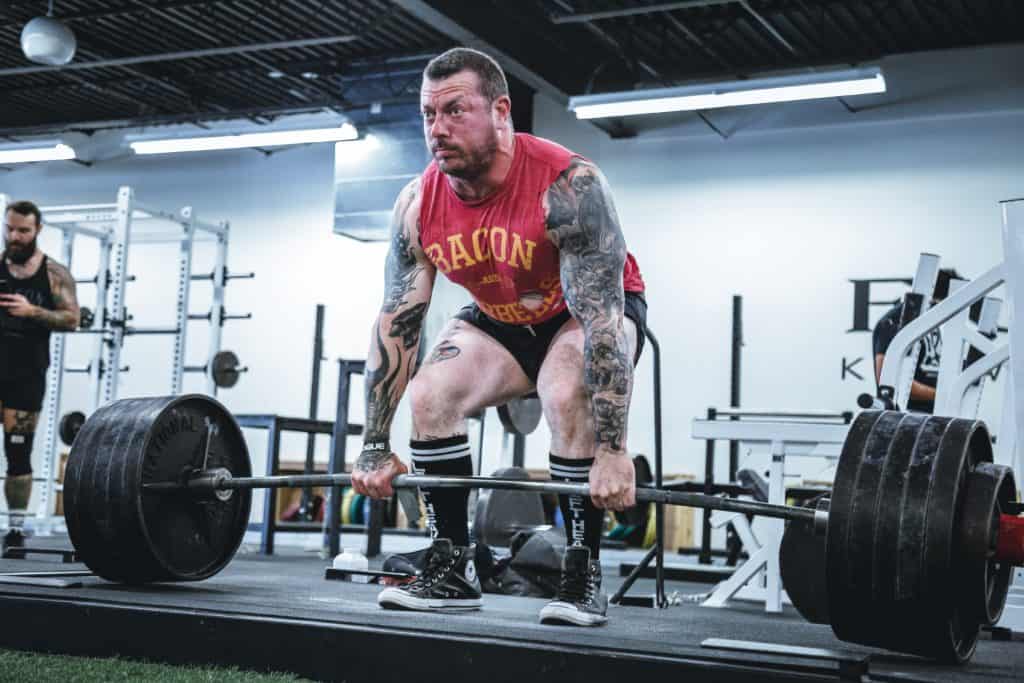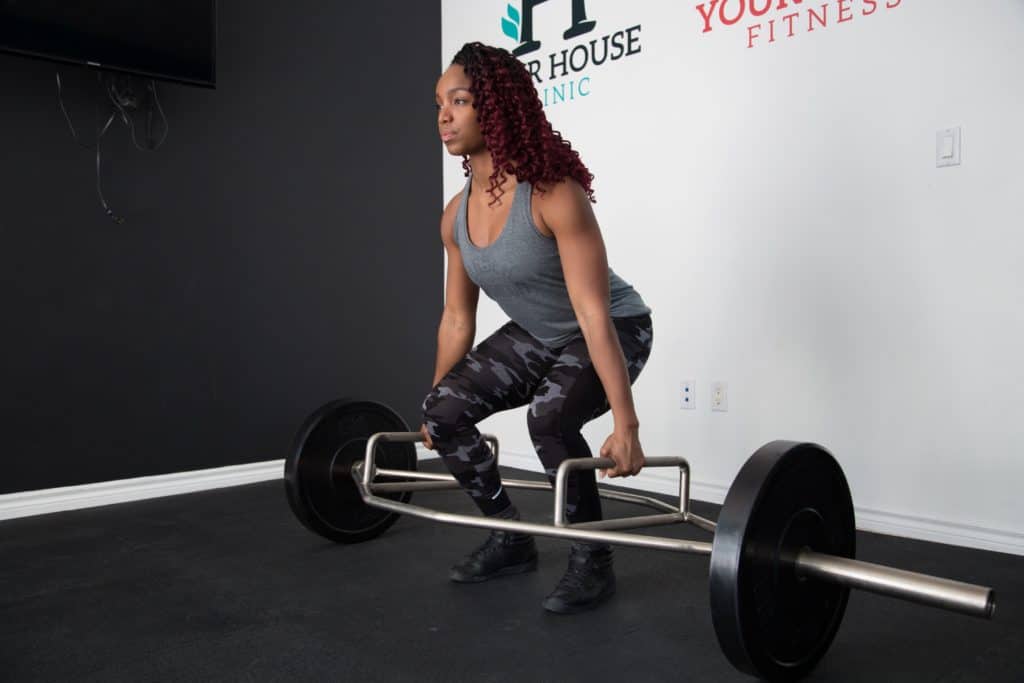
Many experienced lifters will tell you that the deadlift is a necessity to build a wide, muscular back.
Deadlifts, squats, and bench press are considered the holy grail of exercises. These compound movements engage a range of muscle groups and have been a part of standard workout routines for decades.
While these exercises are the foundation of powerlifting, you will still see bodybuilders, strongmen competitors, and professional athletes incorporate them into their programs as they have application across many training styles.
Deadlifts in particular have mainstream appeal. The ability to lift heavy weight off the ground has the impressive wow factor, more so than other lifts. An athlete can likely deadlift more weight than they could squat or bench.
The deadlift comes with some risk, however. To the average person it may just seem like you bend the knees and lift the weight up. But the deadlift is one of the more technical compound exercises.
For one reason or another, some people choose not to deadlift. It may be due to injury, discomfort, or general apprehension about form and execution. It’s not unusual for people simply to have a bad back and want to play it safe even if they’ve never tried the exercise.
However, since we are told how great of an exercise deadlifting is, some people may be concerned that they are missing out on potential muscle gain if it isn’t part of the workout program.
The deadlift exercise is a compound movement primarily utilizing the quadriceps, hamstrings, glutes, and erector spinae. There are two main ways to deadlift; sumo and conventional. Sumo takes a wider stance with toes pointed out, while conventional is a shoulder width stance with feed pointed forward.
Deadlifts are not a requirement to build large back muscles, especially since they don’t engage the lats; which are responsible for overall back width. Even trapezius muscle activation is considered secondary compared to muscles in the legs and lower back when deadlifting.
Deadlifts are considered a high risk/reward exercise, but in terms of muscle development, the reward is not all that valuable. There are a variety of safer exercise alternatives to build a physique. In fact, there is probably not a single exercise targeting any muscle group that cannot be substituted with similar results.
As mentioned, the deadlift only targets the erector spinae when it comes to the vast collection of muscles in the back. It’s important to note that the erector spinae, or spinal erectors, are a group of muscles that run the length of the entire back.
With that said, anyone who has performed deadlifts will state that the majority of the tension is in the lower back, not the middle to upper back. Development and strengthening of the lower back is great for a variety of reasons, but is not a major component of a muscular physique.
If anything, you could say the deadlift is an overrated exercise for building muscle and is more appropriate for strength training. Still, people will look for replacement exercises to make up for what they feel is lost. Luckily there are more than enough alternatives you can turn to.
What Exercise Can Replace Deadlifts
When looking at alternative exercises, it’s important to try to find something that will not only target the same muscles, but also follow a similar movement pattern.
The most obvious substitute for conventional deadlifts is a Romanian deadlift, sometimes called a stiff legged deadlift.
A Romanian deadlift (RDL) is almost like a conventional deadlift in reverse. The movement starts with the barbell at hip level. The user shifts their hips backwards, with minimal knee bend, as the weight slides down the leg.
In many cases, the barbell will not reach the floor. This is a matter of the individual’s flexibility and what muscles they want to focus on (lowering the bar closer to the ground incorporates more lower back activation).
A good indication of proper form is if you feel a stretch in the hamstring as the weight is being lowered. The Romanian deadlift will adequately target the glutes, hamstrings, and erector spinae. These are 3 of the 4 major muscle groups used in conventional deadlifts, with the similar movement pattern as well.
The only missing piece is quadriceps activation, which makes sense since the Romanian deadlift takes the knee bend out of the equation. However, there are more than enough ways to target quadriceps in a workout; with exercises like squats, split squats, lunges and leg presses.

There is a variation of the deadlift called the trap bar deadlift, which uses a hex bar that the lifter stands in the middle of. The trap bar deadlift has the same movement pattern as the conventional deadlift, but with different hand placement.
The trap bar deadlift places more emphasis on the quadriceps and less tension on the lower back. This may be an alternative for individuals with a bad back but want a similar movement.
One advantage of an RDL is safety. With RDLs you can ease into each repetition. Range of motion can start short and increase as you feel more comfortable with balance and form. With conventional deadlifts this is not possible, as you cannot simply stop in the middle of the exercise without risking injury.
Keys to Building Large Back Muscles
While the back contains a conglomeration of different muscles, the ironic thing is that there are only a few basic exercises needed to hit them effectively.
Back exercises can be boiled down to pulldowns, rows, and shrugs. The key is to have enough variation to hit the muscles at different angles. For example, rows could be bent over rows, seated cable rows, one arm rows, or pendlay rows. These four exercises all target the back muscles in a different way, even though they are all considered rowing movements.
Beyond that, there are dumbbells, barbells, smith machines, and cables. So within the basic movement pattern of a row are almost limitless options that can be incorporated into a training program.
The same applies for lat pulldowns. While the motion may be the same, you can change grips or grip width. Grips can be neutral, overhand or underhand. They can also be close or wide. Pullups fall into the same category as well.
Traps can be developed with shrugs and upright rows. Similarly, there is variation among barbells, dumbbells and cables within each exercise.
As mentioned, a great deal of tension during the deadlift is placed on the lower back. Lower back exercises can be lost in the shuffle of an entire workout. The lower back is a crucial component of core strength and posture. Be sure to incorporate exercises like planks, supermans, and back extensions into the routine.
When you consider all of the options, it’s easy to see how one could develop a large, muscular back without the need to deadlift. If you are not getting the results you desire using the basics, there are a number of alternative exercises to build lat muscles.
Back Workout Without Deadlifts
This back workout is under the guise that the individual is using split training, with each muscle group getting its own day. Anyone utilizing higher frequency training like full body or push/pull/legs can easily pick apart the exercises and incorporate them into their routine.
This routine is balanced and simply a guideline for a general back workout. The keys for muscle growth are mechanical tension and training volume. Mechanical tension is the ability to place load on the muscle with proper form, while training volume is the amount of work the muscle performs (commonly measured as total working sets per muscle per week).
If there is a particular aspect of the back musculature which you seek to improve, it should garner more attention (i.e. more training volume).
If you wish to widen the back, you should place an emphasis on exercises like pull-ups and lat pulldowns. In exchange, you may take volume from an area that does not need much work. For example, if traps don’t need additional development, you could do fewer sets of shrugs or upright rows in lieu of the additional lat exercises.
| Exercise | Sets | Reps |
| Underhand Grip Cable Lat Pulldown | 3 | 12 |
| Barbell Bent Over Row | 4 | 8 |
| Dumbbell Shrugs | 4 | 10 |
| Back Extensions | 3 | 15 |
Recent Posts
There is no greater appeal in the fitness world than the prospect of eating junk food and still effectively building muscle. With how calorie dense fast food is, coupled with the lack of...
Dietary supplements are considered to be a fractional component of bodybuilding as a whole. But when it comes to bodybuilding, especially at the competitive level, it is the finer details that are...
